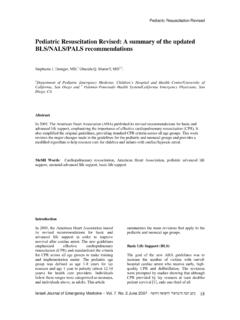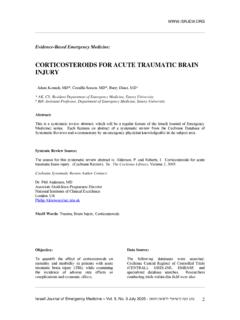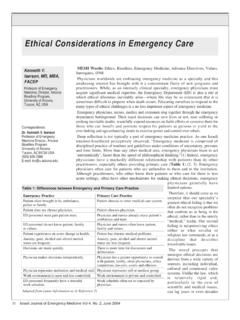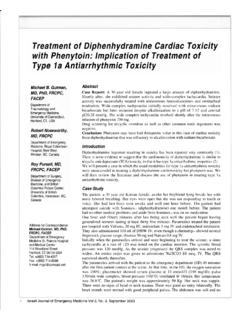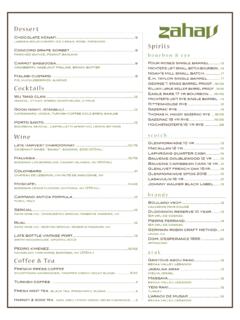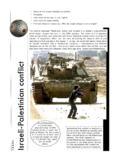Transcription of Adult Intraosseous Access: An Idea Whose Time …
1 Adult Intraosseous access israeli Journal of Emergency Medicine Vol. 6, No. 2 May 2006 - 41 Adult Intraosseous access : An Idea Whose Time Has Come Marvin A. Wayne, MD, FACEP, FAAEM* * Medical Director EMS Bellingham/Whatcom County, Washington, USA Abstract: The author provides an overview of the Intraosseous route for vascular access . Evolution of the practise, equipment, treatment options and contraindications are reviewed. MeSH Words: Intraosseous access ; central line; intravenous care; critical care; shock Introduction and History The use of the Intraosseous (IO) route for vascular access has a significant history. It was first documented by Drinker et al.
2 In 1922 as a method of delivering fluids and medications. They confirmed that substances infused into the bone marrow were quickly absorbed into the central circulation (1). Later, Papper established that the circulation times for fluids administered by IO and IV routes were nearly identical (2). During World War II, IO infusion was widely used, by medical personnel, to resuscitate patients who were in hemorrhagic shock (3). After the war, the use of the technique declined when those with the skills to teach it returned to the civilian population. The rediscovery of IO access , as an alternative to the intravenous route, is attributed to an American pediatrician, James Orlowski.
3 While working in India during a cholera epidemic, he observed medical personnel using IO access to save patients in whom IV cannulation was difficult or impossible, and who might have died without access . His famous 1984 editorial, My Kingdom for an IV Line (4), advocated the use of IO infusion in pediatric patients. Since the late 1980s pediatric IO infusion has been a recommended practice in the American Heart Adult Intraosseous access israeli Journal of Emergency Medicine Vol. 6, No. 2 May 2006 - 42 Association Pediatric Life Support (PALS) guidelines (5). The Case for Adult Intraosseous access Rapid vascular access is a necessity when a patient, pediatric or Adult , is in hemodynamic or cardiac compromise.
4 In the United States, thousands of patients are treated in the out-of-hospital setting, and of these, there is a significant number in whom intravenous access is difficult or impossible to achieve (6). In some, failed access may increase morbidity and mortality. Similar delays may even occur in the hospital setting. Fluids and medications infused via IO lines reach the central circulation within one second, equivalent to the speed of an intravenous line (7). Moreover, while IV access requires an average of ten minutes to achieve, IO access can generally be achieved in less than one minute (8). Any currently approved medication or blood product that can be infused intravenously can be safely infused via the Intraosseous route.
5 Thus, Intraosseous access may provide significant time-saving, which may benefit the critical patient. Recently issued guidelines, by both the American Heart Association (9) and European Resuscitation Council (10), recognize the importance of Intraosseous vascular access as a first alternative to the IV route. Available Devices Current technologies for Intraosseous access employ three methodologies for needle (cannula) placement: manual, impact driven, and powered drill. Most manually inserted devices have been available for some time: Jamshidi and Ilinois Sternal (Cardinal Health Care), and Dieckmann (Cook Critical Care).
6 The manual model of the EZ-IO has recently been introduced (VidaCare). Impact driven devices also have been available for some time. These devices include hollow steel needles with removable trocars to prevent plugging of the needle with bone fragments during insertion. The time required for preparation and insertion varies with the device used. One impact-driven device, FAST 1 (Pyng Medical), is designed only for sternal access . It requires an estimated 50 seconds for preparation and insertion (11). The second, (WaisMed Ltd.), is designed to access the medullary space of the tibia and requires an estimated 17 seconds for preparation and insertion (12).
7 Both of these devices require careful stabilization of the insertion site prior to, and during, insertion to prevent inappropriate placement. In the case of the , a potential exists for operator or patient injury if the device is accidentally triggered or misdirected (11). A relatively new drill-based device, the EZ-IO, AD and PD (VidaCare), Adult and pediatric models, respectively, utilizes a hand-held battery-powered device to drill an IO needle into the Intraosseous space. Estimated time for preparation and insertion is generally less than ten seconds (8). Flow rates vary, depending upon the device used, age, anatomy of the patient, insertion site, and the use of a pressure pump.
8 In general, the volume of fluid given per unit time is similar to a 21-gauge IV catheter (13). Flushing of the IO needle after insertion is recommended to improve flow rates (8). The availability of devices for Adult use, for a range of insertion sites, has made the use of Adult Intraosseous more practical. The site most commonly used, in both adults and children, is the proximal tibia, just medial and inferior to the anterior tibial tubercle. Other insertion sites, in adults , include the sternum and humeral head. The choice of site depends on the age and condition of the patient, and the training and experience of the operator. Limitations and Contraindications The preferred method of vascular access in emergency patients is the intravenous route.
9 However, speed of access is often an important factor in preventing patient morbidity or mortality. If the time required to place an intravenous line could compromise a patient s condition, then the Intraosseous route should be utilized. Both American Heart Association and European Resuscitation Council guidelines state that Intraosseous access should be the first alternative to failed intravenous access (9,10). Adult Intraosseous access israeli Journal of Emergency Medicine Vol. 6, No. 2 May 2006 - 43 There are patients in whom IO access may not be practical. For example, in obese patients, the needles may not be long enough to reach the marrow space.
10 The need for ongoing chest compressions may be a factor in determining the appropriate insertion site. Patients with lower extremity trauma or amputations may require an alternative IO site. There are several other contraindications. These include fractures above the IO insertion site, infection at the insertion site, local vascular compromise, previous sternotomy, and previous orthopedic procedures in the area of insertion, such as total knee replacement. Complications Few complications have been reported in association with Intraosseous access (14). In a prospective, 250 patient, multi-center study of the EZ-IO drill device, there were no cases of osteomyelitis, fat embolism, fracture, infection, extravasation, or compartment syndrome (8).

